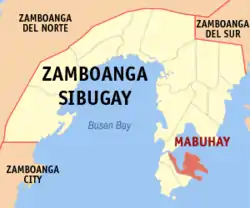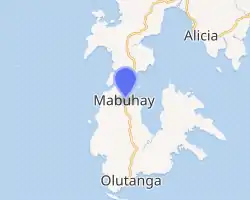Mabuhay, Zamboanga Sibugay
Mabuhay, officially the Municipality of Mabuhay (Cebuano: Lungsod sa Mabuhay; Chavacano: Municipalidad de Mabuhay; Tagalog: Bayan ng Mabuhay), is a 4th class municipality in the province of Zamboanga Sibugay, Philippines. According to the 2015 census, it has a population of 36,870 people. [3]
Mabuhay | |
|---|---|
| Municipality of Mabuhay | |
 Map of Zamboanga Sibugay with Mabuhay highlighted | |
OpenStreetMap 
| |
.svg.png.webp) Mabuhay Location within the Philippines | |
| Coordinates: 7°25′03″N 122°50′13″E | |
| Country | |
| Region | Zamboanga Peninsula (Region IX) |
| Province | Zamboanga Sibugay |
| District | 1st District |
| Barangays | 18 (see Barangays) |
| Government | |
| • Type | Sangguniang Bayan |
| • Mayor | Edreluisa O. Caloñge |
| • Vice Mayor | Restituto O. Calonge |
| • Representative | Wilter W. Palma II |
| • Electorate | 14,119 voters (2019) |
| Area | |
| • Total | 82.85 km2 (31.99 sq mi) |
| Elevation | 8.0 m (26.2 ft) |
| Population | |
| • Total | 36,870 |
| • Density | 450/km2 (1,200/sq mi) |
| • Households | 6,783 |
| Economy | |
| • Income class | 4th municipal income class |
| • Poverty incidence | 59.13% (2015)[4] |
| • Revenue | ₱87,476,693.90 (2016) |
| Time zone | UTC+8 (PST) |
| ZIP code | 7010 |
| PSGC | |
| IDD : area code | +63 (0)62 |
| Climate type | tropical climate |
| Native languages | Subanon Cebuano Chavacano Tagalog |
| Website | www |
The municipality is located in the northeastern part of Olutanga Island.
Barangays
Mabuhay is politically subdivided into 18 barangays.
- Abunda
- Bagong Silang (Tumalog)
- Bangkaw-bangkaw
- Caliran (Turko)
- Catipan
- Kauswagan
- Ligaya
- Looc-Barlac
- Malinao (Sagasa)
- Pamansaan
- Pinalim (San Roque)
- Poblacion (Mabuhay)
- Punawan
- Santo Niño (Tobi-an)
- Sawa
- Sioton
- Taguisian
- Tandu-Comot (Katipunan)
Climate
| Climate data for Mabuhay, Zamboanga Sibugay | |||||||||||||
|---|---|---|---|---|---|---|---|---|---|---|---|---|---|
| Month | Jan | Feb | Mar | Apr | May | Jun | Jul | Aug | Sep | Oct | Nov | Dec | Year |
| Average high °C (°F) | 31 (88) |
31 (88) |
31 (88) |
31 (88) |
30 (86) |
29 (84) |
29 (84) |
29 (84) |
29 (84) |
29 (84) |
30 (86) |
30 (86) |
30 (86) |
| Average low °C (°F) | 23 (73) |
23 (73) |
23 (73) |
24 (75) |
25 (77) |
25 (77) |
24 (75) |
24 (75) |
24 (75) |
24 (75) |
24 (75) |
23 (73) |
24 (75) |
| Average precipitation mm (inches) | 61 (2.4) |
55 (2.2) |
75 (3.0) |
81 (3.2) |
145 (5.7) |
189 (7.4) |
189 (7.4) |
197 (7.8) |
162 (6.4) |
181 (7.1) |
115 (4.5) |
70 (2.8) |
1,520 (59.9) |
| Average rainy days | 16.4 | 15.7 | 19.1 | 21.5 | 26.9 | 27.1 | 26.4 | 25.0 | 24.2 | 26.8 | 23.5 | 18.7 | 271.3 |
| Source: Meteoblue [5] | |||||||||||||
Demographics
| Year | Pop. | ±% p.a. |
|---|---|---|
| 1970 | 13,349 | — |
| 1975 | 21,562 | +10.09% |
| 1980 | 9,141 | −15.77% |
| 1990 | 13,292 | +3.82% |
| 1995 | 19,512 | +7.46% |
| 2000 | 25,199 | +5.64% |
| 2007 | 30,589 | +2.71% |
| 2010 | 33,093 | +2.90% |
| 2015 | 36,870 | +2.08% |
| Source: Philippine Statistics Authority [3] [6] [7][8] | ||
References
- Municipality of Mabuhay | (DILG)
- "Province: Zamboanga Sibugay". PSGC Interactive. Quezon City, Philippines: Philippine Statistics Authority. Retrieved 12 November 2016.
- Census of Population (2015). "Region IX (Zamboanga Peninsula)". Total Population by Province, City, Municipality and Barangay. PSA. Retrieved 20 June 2016.
- "PSA releases the 2015 Municipal and City Level Poverty Estimates". Quezon City, Philippines. Retrieved 12 October 2019.
- "Mabuhay: Average Temperatures and Rainfall". Meteoblue. Retrieved 1 May 2020.
- Census of Population and Housing (2010). "Region IX (Zamboanga Peninsula)". Total Population by Province, City, Municipality and Barangay. NSO. Retrieved 29 June 2016.
- Censuses of Population (1903–2007). "Region IX (Zamboanga Peninsula)". Table 1. Population Enumerated in Various Censuses by Province/Highly Urbanized City: 1903 to 2007. NSO.
- "Province of Zamboanga Sibugay". Municipality Population Data. Local Water Utilities Administration Research Division. Retrieved 17 December 2016.
External links
- Mabuhay Profile at PhilAtlas.com
- Philippine Standard Geographic Code
- Philippine Census Information
- https://web.archive.org/web/20080508205738/http://digitalmabuhay.com/
This article is issued from Wikipedia. The text is licensed under Creative Commons - Attribution - Sharealike. Additional terms may apply for the media files.